Kayaking is fun, adventurous, and a great way to explore nature. However, like any other water sport, it has some risks associated with it that should be taken into consideration. Many people are concerned about kayaking safety, but with the right precautions, it can be a safe and enjoyable activity.
Most kayaking accidents are due to improper preparation or equipment failure. To minimize your risk of danger while kayaking, make sure you use appropriate clothing, footwear, and life jackets that fit properly. In our blog post “Is kayaking dangerous?”, we will aware you of the potential dangers associated with kayaking and how to avoid them.
Contents
Contents
Is Kayaking Dangerous?
The answer is yes, kayaking can be dangerous if the proper safety precautions are not taken. It’s important to remember that while you can’t control the environment, you can control your preparation and equipment.

Kayaking in dangerous and unpredictable environments can lead to serious harm or even death. It can be difficult to control the kayak due to wind, waves, and other environmental factors. Also, many hazards can cause an unsafe environment such as rocks, shallow water, currents, and marine life.
Is Ocean Kayaking Dangerous?
When it comes to kayaking in the ocean, one of the greatest risks is capsizing or being swept away by a strong current. If you are kayaking in the ocean, it’s important to pay attention to water conditions and be aware of your surroundings. Make sure you always wear a life jacket and keep away from any dangerous areas such as rocks or shallow water.
If you are a professional kayaker and want to explore more challenging routes, make sure you get the proper training beforehand. Don’t take on anything that is beyond your skill level. Take care of yourself and others with you by being mindful of ocean conditions and following the necessary safety measures.
Is River Kayaking Dangerous?
Many kayakers view river kayaking as a much safer activity than ocean kayaking. However, rivers can have some unexpected obstacles and dangerous currents that can lead to capsizing or injury if you are not prepared.
It’s important to be mindful of any obstacles such as rocks or rapids that may exist in the water and keep away from them. Also, be aware of the current and avoid any areas that may be too dangerous. Wear a life jacket at all times, even when you are kayaking in calmer waters.
Is Whitewater Kayaking Dangerous?
Whitewater kayaking is an extreme sport that should only be attempted by experienced and skilled kayakers. The unpredictable rapids, waves, and currents can be dangerous and cause injury if you are not trained properly.
We always recommend taking a class or hiring a guide before attempting any whitewater kayaking. They will be able to provide you with the necessary safety measures and knowledge to make your paddling experience as safe as possible.
Is Sea Kayaking Dangerous?
Kayaking on the sea can be a peaceful and enjoyable experience. However, it can also be more dangerous due to the presence of large waves, strong winds, and unpredictable currents. It’s important to research the area before venturing out and take proper safety precautions such as wearing a life jacket at all times.
Is Kayaking In Lake Dangerous?
We all love the serenity of kayaking in a lake and it can be a safe experience if you are properly prepared. Make sure you check for any strong winds, shallow areas, rocks, or other potential hazards. Also, wear a life jacket at all times and avoid any sections where the water is too deep or too fast-moving.
Perceived Risk Vs Actual Risk
The key to safe kayaking is understanding the difference between perceived risk and actual risk. Perceived risk is how dangerous you think a situation is while the actual risk is how dangerous a situation is. The benefit of having a high perceived risk is that you are prepared for the worst-case scenario and take all necessary safety precautions. On the downside, high perceived risk can make you anxious or hesitant about getting on the water.
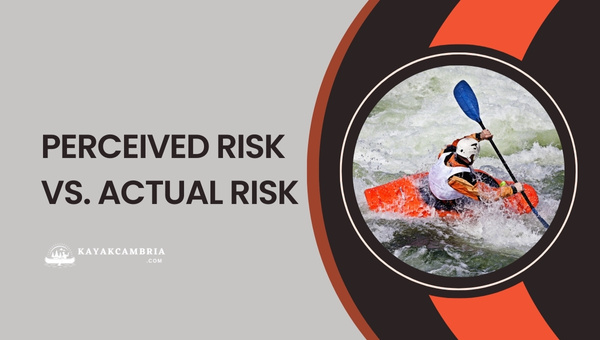
It’s also important to understand the difference between perceived and actual risk when it comes to safety. Even if you think a situation is safe, it may be dangerous. Taking unnecessary risks can lead to accidents and injuries.
Risks Associated With Kayaking and How To Avoid Them?
There are several risks associated with kayaking including drowning, hypothermia, dehydration, and many more. The different types of risks are discussed below:

1. Capsizing
The most common and deadly kayaking situations will involve flipping the kayak over and the worst case can get trapped underneath it. Capsizing is especially dangerous when you’re far from land in deep water or paddling a river with rocks and rapids. The suddenness of the situation can take you from a relaxing paddle to fighting for your life mode in seconds.
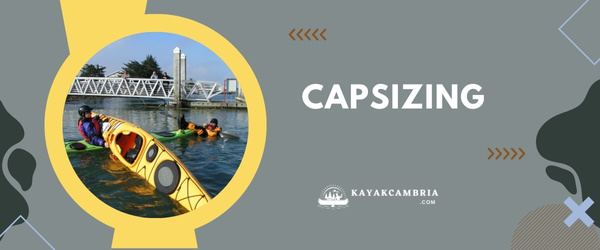
How to Avoid Capsizing:
To safely avoid the risk of capsizing, you need to be familiar with how to re-enter your kayak if you do capsize, how to perform self-rescue, and not panic. Make sure to always wear the correctly fitted buoyancy aid and for whitewater paddling, a helmet too.
2. Hypothermia And Cold Shock
The sudden immersion in dangerously cold waters can lead to cold shock and hypothermia, both of which can be fatal. The sudden drop in very low cold temperatures can lead to a rapid increase in breathing and blood pressure. You can also lose the ability to hold your breath, swim or tread water and this can lead to drowning.
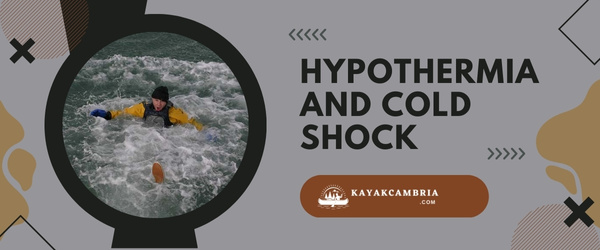
It is important to know the water temperature and wear appropriate clothing, life jackets and helmets. It’s also important to know your limits and not paddle in waters that are over your head. This is especially true in colder waters.
How to Avoid Hypothermia And Cold Shock:
You can avoid the risk of hypothermia and cold shock by wearing a wetsuit or a dry suit, PFD (personal flotation device), helmet, gloves, and boots. Bring a float and learn how to identify and treat the symptoms of cold shock and hypothermia. Most importantly, remember your limits and don’t paddle in waters that are too deep or cold for your skill level.
If you are done struggling in cold water then remember the 1-10-1 rule i.e:
- One minute to regain control of your breathing
- Ten minutes of meaningful movement to self-rescue
- One hour before you lose consciousness due to hypothermia.
It is important to know the signs and symptoms of cold shocks, such as shivering, difficulty speaking, and reduced coordination. Knowing these signs and taking appropriate action can help reduce the risk.
3. Incorrect PFD Fitting
Personal flotation devices (PFDs) save lives but only if they are worn correctly and fit the size and shape of the wearer. Many people underestimate their size, which can lead to incorrect fitting PFDs. This can cause them to slip off or not be able to support a person’s weight in the water.
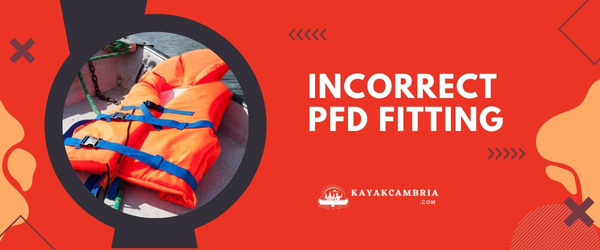
It is important to try on a PFD before buying it so you can make sure it fits correctly and will be comfortable. Additionally, in many places, it’s a legal requirement to have a US Coast Guard-approved life jacket on board when kayaking.
How to Avoid Incorrect PFD Fitting:
To avoid the risk of incorrect fitting PFDs, make sure to try on the PFD before buying it. When you buy a PFD, check that you can adjust it to fit your size and shape and that it can support your weight when in the water. Make sure not to slip it over your head without opening as this can lead to incorrect fitting which may put you at risk of drowning.
Additionally, make sure to always wear the correctly fitted PFD when kayaking and ensure that it is US Coast Guard-approved. This will help keep you safe in case of an emergency.
4. Dehydration
Dehydration is a danger when kayaking on a hot day or doing a lot of physical activity. The symptoms of dehydration include dizziness and fatigue, fainting, confusion, and a rapid heartbeat. In hot temperatures, dehydration can happen quickly and can be serious and even life-threatening if left untreated. This is why it is important to stay hydrated when kayaking, especially in hot temperatures.

How to Avoid Dehydration:
The best way to avoid dehydration while kayaking is to bring plenty of water, and even some electrolyte powder, with you. It can also be helpful to store a bottle of water or electrolyte drink inside the cockpit so it is easily accessible when needed.
You can attach the bottle securely to your kayak with carabiner clips so nothing will spill in the event of a capsize. Additionally, wear loose-fitting clothing and a hat to help stay cool on hot days. By following these simple tips, you can avoid becoming dehydrated while kayaking.
5. Inappropriate Equipment
Inappropriate equipment can be dangerous in any situation, particularly while kayaking. The PFD (personal flotation device) is the most important, and you should wear it at all times while on the water. The PFD is not enough to keep you safe as you will be in charge of everything else that you bring with you.
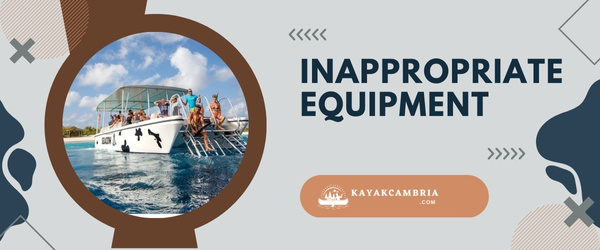
You need to get a kayak that is appropriate for the intended use and paddling environment. For example, you should not be taking a touring kayak down a stretch of river rapids, nor should you be paddling a playboat across a large lake. Make sure to choose the right type of kayak and paddle for your adventure.
You should also keep essential boating equipment with you, such as a kayak light for navigation, a noisemaker, a first aid kit, and visual distress signals.
How to Avoid Inappropriate Equipment:
You need to choose the right kayak for your purpose and paddling environment. In addition to this, you should also make sure to bring the essential boating equipment with you. Keep all the essential equipment according to the type of kayaking and weather conditions, as whitewater kayaking required different gear as compared to kayaking touring.
6. Sun Exposure
If you are out kayaking for a long time, you are directly exposed to the sun’s UV radiation which can lead to skin and eye conditions like sunburns. This can also lead to a serious problem i.e skin cancer. There is more possibility if you are paddling over a sit-on-top kayak. Exposure to UV rays can be very painful and can cause serious damage if not treated.

How to Avoid Sun Exposure:
Always wear UV-resistant clothing and apply a high-factor eco-friendly sunscreen all over your exposed skin. You should also cover your skin with loose clothing and wear a hat to protect your head and neck. Don’t forget to bring plenty of water, as dehydration can be dangerous in hot temperatures.
7. Waves, Tides, And Currents
These natural forces can be dangerous when kayaking and can cause capsizing and other serious problems. The oceans are known to have the strongest and most unpredictable waves, if the waves are too high, it can be difficult to paddle through them. The tides and currents have the power to take you away from your intended destination and should be taken into consideration when kayaking.

How to Avoid Waves, Tides, And Currents:
While kayaking, it is important to be aware of the water conditions. You should know the area’s waters and use that knowledge to plan your kayaking route. You should also consider weather conditions before going, as sudden changes in the weather can lead to high waves and cause you to capsize. So, it is advisable to paddle with someone who knows the area or plan your kayaking route with caution.
8. Strainers and Sweepers
The Strainers and Sweepers are submerged obstacles that can cause serious damage to the kayaker. Sweepers are fallen trees and low-hanging branches that stick out above the water, while strainers are underwater obstacles such as fallen trees and rocks that allow water to flow but block debris in the water. These can trap anything including your kayak, which can cause capsizing.
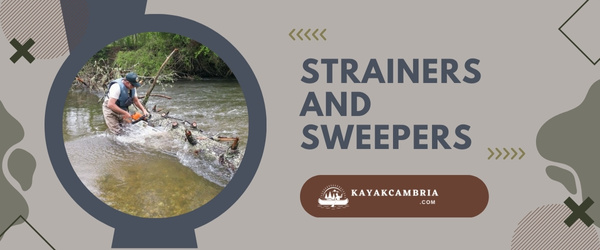
How to Avoid Strainers and Sweepers:
The better way to avoid strainers and sweepers is by avoiding paddling toward them. If you see any in your path, try to portage around them if possible. You should also remain calm and be aware of your surroundings. If your kayak does get stuck, it is important to stay calm and not panic.
9. Wildlife
The chance to discover wildlife while kayaking is a great experience, from interesting sunbathing seals to jellyfish and a flock of angry swans. You should never disturb any wildlife while paddling, as this can be problematic and a serious safety risk. While kayaking, it is important to be aware of dangerous animals like snakes, sharks, and alligators as they can attack when provoked.

How to Avoid Wildlife:
To avoid disturbing wildlife, you should keep your distance and not feed them. This will not only protect you but also the animals. It is also important to store any food inside your kayak, as this will stop wildlife from bothering you for food. This will also keep you safe from potential predators.
10. Exhaustion
While kayaking on hot days, there is a chance of getting exhausted or dehydrated. This can be dangerous and potentially life-threatening. When you are excessively physically active and exposed to sunlight, this can cause dehydration. Symptoms like dizziness, headache, fatigue, nausea, or unconsciousness should not be ignored as they can be signs of exhaustion.

How to Avoid Exhaustion:
The best way to avoid exhaustion is by drinking plenty of water and taking regular breaks. If you feel any symptoms, you should stop paddling and take a break, or call for help. Also, if the temperature is very high, it’s best to drink water regularly and add electrolyte powders for more energy. You should keep your bottle closed at all times and avoid drinks with high caffeine content.
11. Getting Lost
Another risk associated with kayaking is getting lost. This can occur in open waters, where a strong tide or current can blow you off your intended path. It can be more serious if there is fog and you get confused about which way to go. It is important to be aware of the conditions and take action to avoid getting lost.
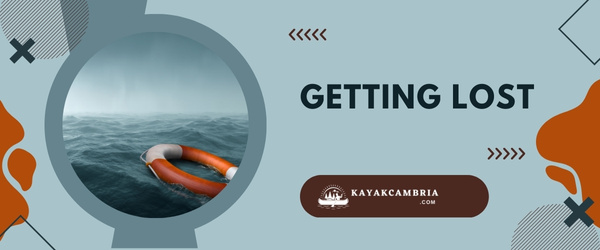
How to Avoid Getting Lost:
It is important to do paddling in a group to avoid the risk of getting lost. This will make it easier for you to stay on the right track, as more eyes are watching out for potential danger. If you are paddling solo, then make sure to remain in sight of the shore. You should also consider carrying a waterproof GPS device and using a compass if needed for navigation.
12. Drowning
Drowning is one of the most serious risks associated with kayaking. The risk of drowning is higher when paddling in deep waters, kayaking alone, and if you are unprepared and don’t know swimming. It can be very dangerous if your kayak flips and you don’t know how to swim.
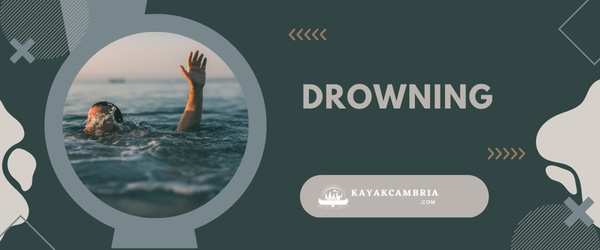
How to Avoid Drowning:
To avoid drowning, it is important to wear a correctly-fitted life vest at all times and follow safety procedures. It is also important to get self-rescue training and practice capsize drills in safe conditions. Knowing how to deal with fear and regain control in a potentially life-threatening situation can save your life.
13. Drinking and Paddling
Paddling under the influence of alcohol can be extremely dangerous and should be avoided. Alcohol affects your mind, vision, and coordination, making it difficult to navigate properly and react quickly. Drinking alcohol while kayaking is illegal in many countries, as it can lead to serious fines or imprisonment.

How to Avoid Drinking and Paddling:
The only way to ensure safety while kayaking is to never mix alcohol and paddling. It is better to remain sober while kayaking, as any amount of alcohol, can affect your judgment and ability to make safe decisions.
It can also be helpful to paddle with a partner when you go kayaking, as they can help keep an eye on your safety. If you wish to enjoy a drink while paddling, it is best to do so in a safe spot and stay in the same area.
14. Sports-Related Injuries
Sports-related injuries can occur easily while kayaking due to the repetitive motion of paddling. Strains in the neck, shoulder blades, lower back, and wrists are common risks associated with kayaking. Additionally, improper form or technique can lead to more serious injuries such as broken limbs.
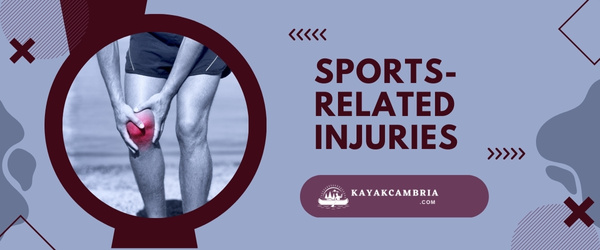
How to Avoid Sports-Related Injuries:
You should always warm up before getting into a kayak and use proper form when paddling. When paddling, make sure to keep your elbows in and move from the hips. When learning to kayak, it is important to start with easier rapids and gradually build up your stamina.
Doing so will help prevent serious injuries and keep you safe while kayaking. You should also not overexert yourself and take frequent breaks when needed.
15. Other Boating Traffic
The waterways can be dangerous places, especially when other boats are present. Kayaks are much smaller and less visible compared to larger boats like motorboats or sailboats. As a result, other boaters may not always be able to see or hear you and can easily run into you. Additionally, since kayaks don’t have an engine, you won’t be able to announce your presence to others.
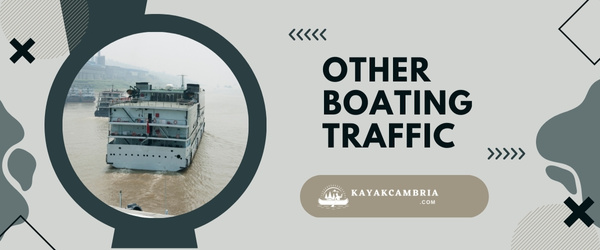
There are larger boats that may be unable to turn fast enough to avoid you, and can easily cause serious injuries.
How to Avoid Other Boating Traffic:
To avoid other boaters and ensure your safety, it is important to stay alert when paddling in waterways. Pay attention to the boats around you, and watch out for any signs of danger. You should also avoid the pathways of larger boats and stay in calmer waters if possible. Lastly, wearing bright clothing and adding reflective strips on your kayak can make you more visible to other boaters.
16. Adverse Weather Conditions
Kayaks are not designed to withstand strong winds, lightning, and other extreme weather conditions. Kayaking in adverse weather can be dangerous as it can cause the kayak to capsize, leaving you exposed and vulnerable. Moreover, sudden temperature drops may affect your body’s ability to stay warm and dry during a trip. The weather conditions like fog can also make it difficult to see, which could lead to navigation errors.

How to Avoid Adverse Weather Conditions:
You should always check the weather forecast before going kayaking, and avoid trips if it calls for dangerous conditions. Have a watch on the sky and take action if you notice any changes in the weather. If you see lightning or hear thunder, immediately rush to the shore and take shelter as quickly as possible. It is also important to dress appropriately for the season to ensure your body stays warm and dry.
17. Inexperience
This is one of the most common risks associated with kayaking, as inexperienced paddlers can easily find themselves in waters beyond their experience level. Experienced paddlers can tackle rough waves on open water, but a lack of experience can be life-threatening.

How to Avoid Inexperience:
Inexperience can be combated with an investment in knowledge and practice. Beginners should learn the basics of kayaking such as how to kayak, where to sit, and basic safety procedures. Practice self-rescue and capsize recoveries in calmer waters until you become comfortable and confident with them, as these are essential skills to prevent accidents on open water. Avoid paddling alone and instead, look for experienced “buddies” to paddle with.
18. Undercut Rocks
Undercut rocks can be difficult to spot and they form a dangerous situation when kayaking, as the water level over them can be so shallow that it causes the kayak to get dragged onto them. This has a high risk of capsizing the boat, which can then lead to dangerous situations.

How to Avoid Undercut Rocks:
To avoid this dangerous situation, it is important to be aware of the depth of the water and potential obstacles in the river. Wear a properly fitted life jacket and helmet at all times when kayaking, as they can offer an extra layer of protection if you do get trapped on an undercut rock. Additionally, learn self-rescue techniques, so you can easily get out of a situation where your kayak is stuck.
19. Weirs & Low-Head Dams
Weirs and low-head dams are manmade constructions that control river levels. They have nasty nicknames, such as ‘drowning machines’ and ‘killers in our rivers’ due to the dangerous hydraulic forces they generate when water flows over them. These currents can trap kayaks and cause them to recirculate like a washing machine, which could cost you your life as it is almost impossible to escape.

How to Avoid Weirs & Low-Head Dams:
If you know that there are weirs or low-head dams present in an area, take extra caution and avoid paddling through them. If possible, paddle away from them and look for warning signs such as special buoys or flags to indicate the dangerous waters. Always wear a life jacket when kayaking and stay away from these currents if at all possible.
Must Follow 8 Safety Tips For Kayakers
After discussing the common risks associated with kayaking, here are some general safety tips to keep in mind:
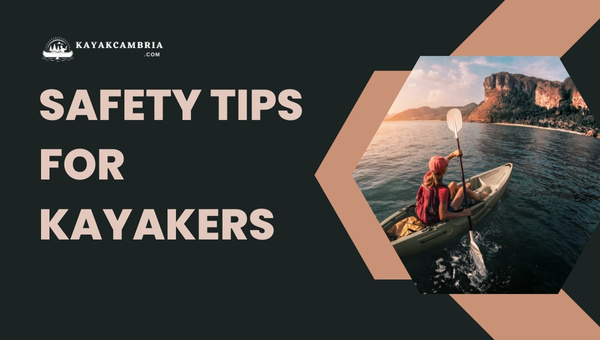
- Wear a properly fitted life jacket and helmet at all times while kayaking.
- Learn proper self-rescue techniques and practice them in calmer waters.
- Avoid paddling through weirs or low-head dams if at all possible.
- Drink plenty of water to avoid dehydration.
- Always be aware of your surroundings and the potential dangers that may exist.
- Avoid kayaking in adverse weather conditions.
- If you are ever in doubt about your safety, don’t take any risks to stay on shore.
- Always paddle with experienced buddies and never paddle out alone.
Frequently Asked Questions
1. Is kayaking dangerous for non-swimmers?
Yes, kayaking can be dangerous for non-swimmers as they lack the ability to swim if ever capsized. It is important for all kayakers to wear a well-fitted life jacket at all times and to stay away from currents that could lead to capsizing.
2. How dangerous is kayaking off the beach?
Kayaking off the beach can be dangerous due to the unpredictability of ocean currents and waves. It is important to stay alert and aware of your surroundings when kayaking in these areas and to avoid paddling alone if possible.
3. Is kayak fishing dangerous?
Fishing by kayak can be dangerous if the weather conditions are adverse, so it is important to always check the weather and avoid going out in high winds or storms. Additionally, paddlers should wear a life jacket at all times when fishing from kayaks.
4. What is perceived risk?
Perceived risk is an individual’s subjective assessment of the degree of danger associated with an activity, event, or situation. It’s based on one’s beliefs and expectations about potential consequences rather than the objective, actual risks involved in an activity.
Final Words
Kayaking is an enjoyable activity that can be enjoyed by all, but it’s important to remember the potential risks involved and to take necessary safety precautions. In this article, “Is kayaking dangerous?”, we discussed the common risks associated with kayaking, safety tips to keep in mind, and FAQs. We hope that this information has been useful and that it encourages you to stay safe and enjoy your next kayaking trip! Happy paddling!

